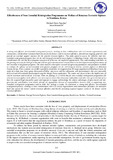| dc.contributor.author | Ngachra, Michael Osew | |
| dc.contributor.author | Kimokoti, Susan | |
| dc.date.accessioned | 2023-09-25T10:20:28Z | |
| dc.date.available | 2023-09-25T10:20:28Z | |
| dc.date.issued | 2023-08-28 | |
| dc.identifier.uri | https://ajernet.net/ojs/index.php/ajernet/article/view/110 | |
| dc.identifier.uri | https://doi.org/10.51867/ajernet.4.2.32 | |
| dc.identifier.uri | http://ir-library.mmust.ac.ke:8080/xmlui/handle/123456789/2292 | |
| dc.description.abstract | A strong and effective non-custodial reintegration process, working in close collaboration with civil society organizations and communities, will facilitate transition back into society for former violent extremist offenders, demonstrate ongoing goodwill, and provide an essential support structure for the returnee terrorist fighters. This study aimed to assess the influence that non-custodial reintegration programs have on the well-being of returned terrorist fighters in Mombasa County, while also taking into consideration the risk that these programs may present if they are not employed appropriately. This understanding contributes to the growing necessity for both governmental and non-governmental actors to contribute to the development and implementation of non-custodial reintegration programs. The study utilized a descriptive research design using quantitative and qualitative methods to evaluate the efficacy of non-custodial reintegration programs on the well-being of returnee terrorist fighters in Mombasa County, Kenya. From a sample size of 400 respondents needed for investigation from the target population of Mombasa Count, the study drew data from focus group discussions (FGDs), interviews with key informants, and questionnaires that were physically delivered and electronically disseminated using the Google Forms application. The county was shown to have the highest rates of violent extremism and recidivism in Kenya. From the findings it is evident that for non-custodial reintegration programmes for returnee terrorist fighters to be effective, it is necessary to ensure that community stakeholders and other non-governmental actors have the required legal and policy space and capacity to engage; acknowledge the relative advantages of government and non-governmental stakeholders; and clearly identify the appropriate division of responsibilities between them in supporting non-custodial reintegration programmes and to make this strategy a reality. In conclusion, a strong and effective non-custodial reintegration process, working in close collaboration with civil society organizations and communities facilitates the transition back into society for former violent extremist offenders and thereby providing required support system to the former violent extremist offenders. | en_US |
| dc.language.iso | en | en_US |
| dc.publisher | AFRICAN JOURNAL OF EMPIRICAL RESEARCH | en_US |
| dc.subject | Effectiveness,Non-Custodial, Reintegration, Programmes, Welfare, Returnee, Terrorist, Fighters, Kenya | en_US |
| dc.title | Effectiveness of Non-Custodial Reintegration Programmes on Welfare of Returnee Terrorist Fighters in Mombasa, Kenya | en_US |
| dc.type | Article | en_US |

